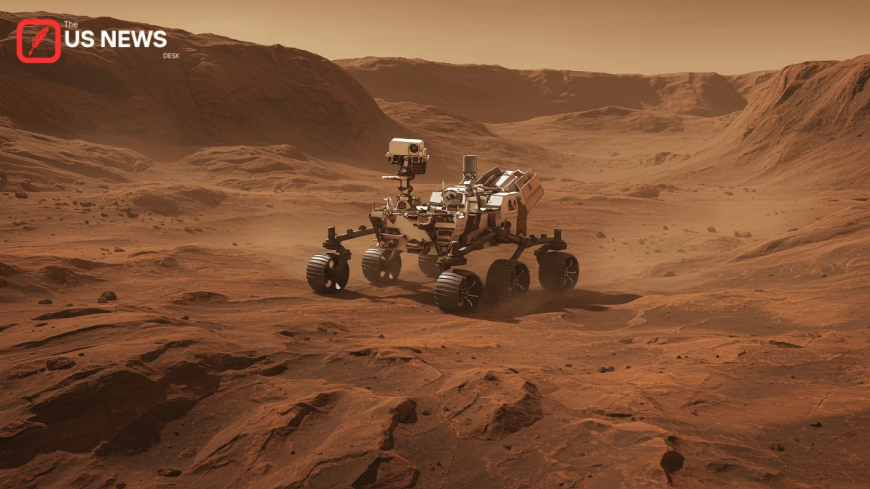NASA Unveils Clearest Evidence Yet of Possible Life on Mars
NASA’s Perseverance rover has detected speckled Martian rocks showing a potential biosignature, marking the clearest evidence yet of possible life on Mars.

In a groundbreaking announcement, NASA scientists revealed that the Perseverance rover has uncovered what may be the strongest evidence of extraterrestrial life ever detected on Mars. The rover’s high-resolution cameras and spectrometers captured images of speckled rock formations in Jezero Crater, which researchers now believe carry a potential biosignature—a chemical or structural feature that could point to ancient microbial activity.
“This is the clearest sign of life that we’ve ever found on Mars,” said Dr. Anjali Patel, a planetary geologist at NASA’s Jet Propulsion Laboratory (JPL). “While it’s too early to claim definitive proof, the textures, mineral deposits, and isotopic ratios we are seeing align with what, on Earth, we would consider markers of biological origin.”
The Speckled Rocks and Why They Matter
The unusual speckled patterns were first identified in images taken in late August by Perseverance’s SuperCam and Mastcam-Z systems. Upon closer spectrographic analysis, the rocks showed high concentrations of carbon isotopes and iron oxides, often linked on Earth to microbial metabolism.
NASA compared these patterns to stromatolites, fossilized layers of microbial mats found in ancient shallow seas on Earth. “The resemblance is striking,” said Dr. Miguel Arroyo, an astrobiologist at the Institute for Advanced Study. “We’re looking at formations that could very well represent microbial colonies that thrived billions of years ago when Mars still had liquid water.”
Biosignature or Geology?
Skepticism remains within the scientific community. Some geologists caution that purely chemical processes—such as crystallization under varying water pressures—could mimic the same structures.
“This is why the upcoming sample return mission is critical,” explained Professor Laura McKinnon, a Mars researcher at Arizona State University. “Only by bringing these rock fragments back to Earth for laboratory analysis can we rule out non-biological explanations.”
NASA plans to cache these samples using Perseverance’s drill system, preparing them for eventual retrieval under the Mars Sample Return mission, scheduled for the early 2030s.
Implications for U.S. Space Policy
The discovery comes at a pivotal moment for U.S. space exploration. The Biden administration and Congress are currently weighing budget allocations for Mars exploration programs versus lunar missions under the Artemis project.
Some policymakers argue that proof of extraterrestrial life—even microbial—would justify increased investment in Mars exploration, given its implications for science, philosophy, and even international competition with China’s Tianwen-3 mission.
“This potential biosignature is not just a scientific milestone—it’s a geopolitical one,” said Senator James Whitfield (R-Ohio) during a Capitol Hill briefing. “The United States must remain at the forefront of this search.”
Human Voices from the Lab
At JPL in Pasadena, researchers who have dedicated decades to the search for life described the emotional weight of the findings.
“Seeing those speckles on the rocks took my breath away,” said Sarah Nguyen, a postdoctoral fellow working on Perseverance data. “For years, we’ve trained ourselves to stay cautious, to not jump to conclusions. But this is the first time I truly felt we might be staring at Martian biology preserved in stone.”
What Happens Next
-
Detailed imaging: Perseverance will continue scanning the surrounding crater floor to map the extent of speckled rock formations.
-
Drill sampling: Core samples will be sealed in tubes for eventual return.
-
Orbital confirmation: NASA’s Mars Reconnaissance Orbiter and ESA’s ExoMars Trace Gas Orbiter will provide atmospheric data to check for related chemical traces.
NASA has stressed that peer-reviewed papers are in preparation, with findings to be published in Science and Nature Astronomy later this year.
The Bigger Question
For decades, the search for life beyond Earth has moved between disappointment and cautious optimism. With this latest discovery, the balance may finally be shifting.
“If confirmed, this would be the single most important discovery in the history of science,” said Dr. Arroyo. “It would mean we are not alone—not now, and not in the history of the universe.”
What's Your Reaction?
 Like
0
Like
0
 Dislike
0
Dislike
0
 Love
0
Love
0
 Funny
0
Funny
0
 Angry
0
Angry
0
 Sad
0
Sad
0
 Wow
0
Wow
0



































